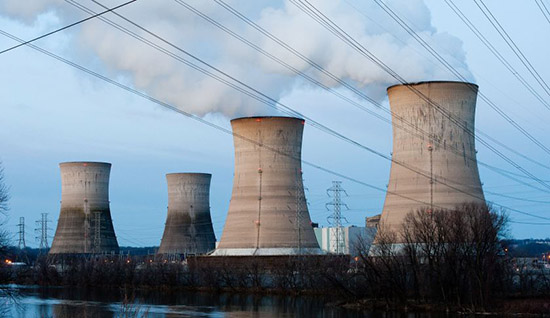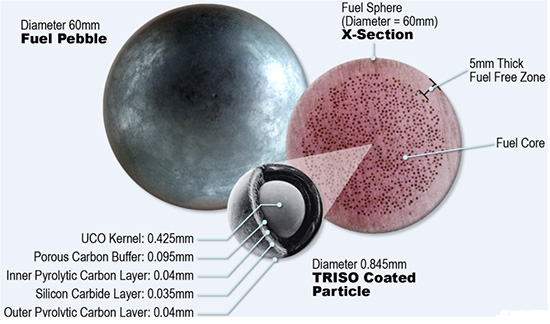这家初创公司要设计更安全、更小的核反应堆

|
几年前,参与创建空间承包公司SGT的伊朗裔美国人、连续创业者甘·加法瑞恩前往法国南部进行了一次精神修行。这次灵魂之旅让他对核能技术产生了兴趣。 加法瑞恩并非是唯一的一位突然对新型核能感兴趣的成功商人。微软联合创始人比尔·盖茨在一家名为TerraPower的核能初创公司投资了数百万美元,亚马逊CEO杰夫·贝佐斯也投资了核聚变初创公司General Fusion。微软另外一位联合创始人保罗·艾伦则看好核聚变初创公司Tri Alpha Energy。 相比开发手机应用、联网设备或数据算法的公司,核能初创公司相对稀少。但现在,数十家核能初创公司有望成就核能领域里的下一个大事件。这些公司成败的关键,是将一种人类急需的能源商业化,这种能源既不会造成气候变化,还可以帮助复兴苦苦挣扎的核能行业。 这趟法国自省之旅,促使加法瑞恩创建了一家名为X-energy的核能初创公司。如果你没听说过这家公司,那也是情有可原的。这家公司自2009年起开始低调运营,致力于采用德国几十年前开发的技术,设计更安全、更小巧的核反应堆。 上个月,这家公司才引起关注,因为它获得了美国能源部提供的4000万美元拨款,用于建造先进的核电反应堆。这笔拨款足以改变行业态势。仅有两家公司获得了政府的财政资助,X-energy便是其中之一。这家公司在十多家竞争对手中脱颖而出,其中包括多家规模达数十亿美元的成熟公司。 当然,公司并不能直接得到全部资金,而是可以在实现里程碑事件时得到拨款。此外,拨款还有成本分摊要求,已在X-energy投入2000万美元的加法瑞恩,已经同意追加投资数百万美元。 X-energy计划利用这笔资金,将员工队伍扩大一倍,增加到约30人,并继续开发其核反应堆设计和燃料生成工艺。借助这笔拨款,X-energy还将与科技领域的多个合作伙伴合作,包括俄勒冈州立大学、爱达荷国家实验室和橡树岭国家实验室。 对于加法瑞恩和科技领域的亿万富翁们来说,对核能技术的兴趣,很大程度上源于通过开发技术产生重要的影响,解决足以改变世界的难题。虽然能源行业规模庞大,但投资新型核能技术,绝非快速轻松的赚钱途径。 加法瑞恩对《财富》杂志表示,他对核能技术的兴趣“带有慈善性质”,是为了“回馈社会”。事实上,新型核反应堆上市动辄需要数十亿美元的投入,因此美国能源部的拨款可谓杯水车薪。但加法瑞恩和X-energy总裁哈伦·鲍尔斯希望美国能源部的拨款,能够吸引新投资者和合作伙伴的兴趣。 X-energy正在研究一种新型核反应堆——球床模块式反应堆。其中的“球”是指网球大小的石墨球,内有带陶瓷涂层的微型铀芯块。这家公司的反应堆内堆积了约17万个这种石墨球,足以进行核子反应,产生热能。 |
When serial entrepreneur Kam Ghaffarian, an Iranian-American who co-founded space contractorSGT, went on a spiritual retreat years ago in the South of France, his soul searching kicked off a new found fascination with nuclear technology. Ghaffarian isn’t the only successful businessman to suddenly become intrigued by new forms of nuclear energy. Microsoft co-founder Bill Gates plowed millions into a nuclear startup called TerraPower, while Amazon’s CEO Jeff Bezos funded nuclear fusion startup General Fusion. Microsoft’s other co-founder Paul Allen became smitten with another nuclear fusion startup called Tri Alpha Energy. While nuclear startups are quite rare compared to those that make mobile apps, connected devices, or data algorithms, dozens of ambitious nuclear startups are now vying to be the next big thing in nuclear energy. At stake is a chance to commercialize a much needed energy source that doesn’t contribute to climate change and which could help revive a struggling nuclear industry. The result of Ghaffarian’s French introspection is a nuclear startup called X-energy, and you’re forgiven if you’ve never heard of it. The company has been operating under the radar since 2009, and working on designs for a safer and smaller nuclear reactor that uses a technology first developed in Germany decades ago. The company was outed last month by what could be a game-changing $40 million grant from the Department of Energy to build its advanced nuclear energy reactor. X-energy was one of only two companies to receive the government financing, and the firm competed against over a dozen companies, many well-established billion-dollar corporations. The company doesn’t receive all of the funds outright, but will have access to the money as, or if, milestones are met. The grant also requires cost-sharing, and Ghaffarian, who has already invested $20 million of his own money into X-energy, has agreed to provide millions of dollars more. X-energy plans to spend the funds on doubling its staff to about 30 people, and continuing development of its reactor designs and fuel creation process. Through the grant, X-energy will also work with a handful of partners on the tech, including Oregon State University, Idaho National Laboratory, and Oak Ridge National Laboratory. For Ghaffarian—and for the tech billionaires, too—the intrigue into nuclear energy tech is largely about advancing technology that can have a big impact on a difficult, world-changing, problem. Despite that the energy markets are vast industries, investing in new nuclear technology is by no means a fast and easy way to make money. Ghaffarian tells Fortune that his interest in the nuclear tech is “philanthropic” and is “about giving back.” Indeed, the DOE grant is a drop in the bucket when it comes to the roughly billion dollars needed to get a new type of nuclear reactor to market. But Ghaffarian, and X-energy’s President Harlan Bowers, are hopeful the DOE recognition will also lead to interest from new investors and new partners. X-energy is working on a type of nuclear reactor called a pebble bed modular reactor. The pebbles are in reference to tennis-ball-sized spheres of graphite, which house tiny pellets of uranium that are coated in ceramic. Inside the company’s reactor they’ll pile up about 170,000 of these pebbles, which is enough to start a nuclear reaction, and generate heat. |

|
我们目前熟知的传统大型核反应堆,多数用水来冷却铀棒。燃料棒需要通过持续的水流来保持冷却。若因任何原因导致水分流失,反应堆会出现过热和融化。后果将不堪设想。 日本福岛核灾难的原因,便是一次大规模地震导致三个反应堆的水冷系统关闭。虽然电力公司最终开始向过热的反应堆注入海水,但为时已晚,反应堆已经释放出了放射性物质。 而X-energy的球床反应堆并不采用水冷,而是通过使氦气流经石墨球来控制温度。除了冷却剂不同外,X-energy公司的鲍尔斯表示,他们所采用的铀(铀235)会在特定温度阈值时开始冷却,基本上可以实现自我调节。 X-energy正在设计的反应堆,规模较小,低于普通的千兆瓦级核电厂。每一座Xe-100反应堆可发电50兆瓦特,或125兆瓦特热量,只是一座千兆瓦级核反应堆发电量的一小部分。但多座Xe-100反应堆可以组装在一起,形成更大的核动力发电机。 由于这种技术采用模块化设计,比传统核电更安全,因此按照加法瑞恩和鲍尔斯的设想,这种技术不仅可用于电网公司,希望不受电网约束发热和发电的公司也可以采用这项技术。加法瑞恩希望将这种技术部署在电网链接前景渺茫的发展中国家。 你或许会疑问,既然球床反应堆技术如此优秀,这么多年来的努力为什么一直没有取得成果?事实上,多年来,德国、南非、美国和中国的多家机构一直在尝试并且建成了这种类型的反应堆,但科学家们一直无法以经济上可行的方式实现商业化,或保证没有技术问题。 当然,X-energy的雄心依旧。目前,公司尚处在概念设计阶段,完成设计需要更长时间。 在未来7到9年内,如果获得所需的资金,该公司向核能管理委员会申请反应堆建造许可。X-energy计划在20年内或到2035年,开始运营一座用来展示的反应堆。 漫长的时间和巨大的资金需求,是导致核能初创公司较少的主要原因之一。要想做好一个需要20年时间才能实现商业化的项目,创业者需要有足够的勇气和坚定的信念。(财富中文网) 译者:刘进龙/汪皓 审校:任文科 |
Most of those older giant nuclear reactors you hear about use water to cool uranium rods. The fuel rods need a constant flow of water across them to keep them cool. If the water is removed for whatever reason, the reactor can overheat and meltdown. And that’s really bad. The Fukushima nuclear disaster was caused when a massive earthquake shut down the water cooling system at three reactors in Japan. The utility eventually started pouring sea water onto the overheating reactors but by then it was too late and radioactive materials had been released. Instead of using water, X-energy’s pebble bed reactor will flow helium across the pebbles to keep the temperature down. But in addition to a different coolant, X-energy’s Bowers says the form of uranium they will use (Uranium 235) starts to cool down at a certain temperature threshold, so it can essentially self-regulate itself. Currently X-energy is designing its reactors at a much smaller scale than the typical gigawatt-scale nuclear plant. Each X-energy reactor, called the Xe-100, will generate 50 megawatts of electricity, or 125 megawatts of heat, just a fraction of what a gigawatt nuclear reactor would produce. But multiple Xe-100’s could be strung together to make much larger nuclear generators. Because the tech is modular and safer than traditional nuclear, Ghaffarian and Bowers envision that it could be used by not just utilities for the power grid, but also companies that want to generate heat and electricity independent of the grid. Ghaffarian hopes that the tech could be deployed in the developing world where power grid access is a distant dream. You’re probably wondering if the pebble bed tech is so great, why haven’t former efforts over the years come to fruition? Many groups in Germany, South Africa, the U.S. and China have tried over the years, and indeed built reactors, but scientists haven’t been able to commercialize the technology economically or without technical issues. Of course all of X-energy’s ambitions are still just that. The company is only at the conceptual design phase, and will need many more years to complete its designs. If the company gets its funding, in maybe seven to nine years, it plans to engage with the Nuclear Regulatory Commission, which doles out licenses to build reactors. X-energy plans to start operating a demonstration reactor within the next twenty years, or by 2035. The long timelines and huge funding challenges are one of the main reasons there aren’t more nuclear startups out there. It takes a brave, and stubborn, entrepreneur to tackle a project that will take 20 years to commercialize. |













